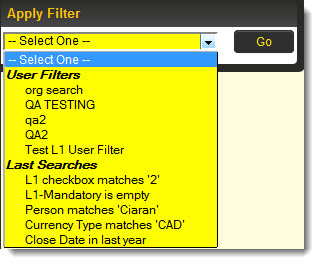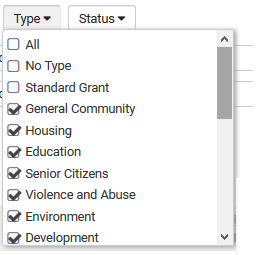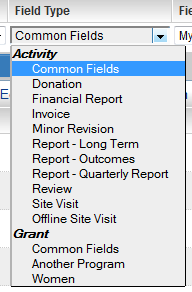Difference between revisions of "Advanced Search"
| Line 9: | Line 9: | ||
To toggle back to the quick search panel, click on the the '''X''' at the top right of the Advanced Search panel. | To toggle back to the quick search panel, click on the the '''X''' at the top right of the Advanced Search panel. | ||
| − | [[Image: | + | [[Image:AdvancedSearchPanel_2017.png|link=|border|900px]] |
| + | |||
| + | |||
| + | |||
| + | ===Select Type and Status=== | ||
| + | |||
| + | [[Image:AdvancedSearchPanel2_2017.png|link=|border|250px]] | ||
| + | |||
| + | When using Advanced Search in UTAs you can filter by the statuses and [[Types|type]] of the object you wish to display. | ||
| + | |||
| + | When using Advanced Search for Users you can filter by the statuses and [[Roles|roles]] of the user you wish to display. | ||
| + | |||
| + | When using Advanced Search for Organizations you can filter by the statuses and [[Client Categories|categories]] of the organization you wish to display. | ||
| + | |||
| + | If all case the Types, Roles, Categories and Statuses search options exist as drop-downs at the top of the Advanced Search option and have the following options: | ||
| + | * All: will return all objects regardless of the Type, Role, Category or Status they have | ||
| + | * No option: will only return those objects without an assigned Type, Role, Category or Status | ||
| + | * Individual options: will only return those objects with the specific selected Type, Role, Category or Status | ||
| + | |||
| + | ===Select Search options=== | ||
| + | |||
| + | [[Image:AdvancedSearchPanel3_2017.png|link=|border|500px]] | ||
| + | |||
| + | When using Advanced Search there are 5 fields that allow you to run a search. | ||
| + | |||
| + | 1. Operators: drop-down displaying the Boolean operators used to narrow focus of the search. | ||
| + | :* '''AND''' indicates that results must contain all words or phrases being searched. | ||
| + | :* '''NOT''' indicates that results should not contain the words or phrases being searched. | ||
| + | :* '''OR''' indicates that results may contain any of the words or phrases being searched. | ||
| + | |||
| + | 2. Field Type: drop-down displaying the types of fields that can be searched against. This includes options such as: | ||
| + | :* '''Common Fields''' - those fields common to all records of a particular entity type | ||
| + | :* Type specific fields - those fields that are specific to a UTA Type, User Role or Org Catergory | ||
| + | :* Fields from other objects - UTA Records allow the ability to search fields that are from associated users and organizations or from parent records | ||
| + | |||
| + | 3. Fields: drop-down displaying the fields that can be searched against. Fields listed here are based on he selected Field Type | ||
| + | |||
| + | 4. Comparison operators: drop-down displaying comparison operators used to match field with search criteria | ||
| + | |||
| + | 5. Search criteria: field to enter the value to be searched for. | ||
| − | |||
===UTA List Views With Ability to Search Organization and Contact Fields=== | ===UTA List Views With Ability to Search Organization and Contact Fields=== | ||
| − | The ability to | + | |
| − | * The organization connected to the | + | The Advanced Search feature for UTAs not only includes the ability to search for fields found in the UTA itself, but also those fields that are from associated users and organizations. |
| − | * The branch connected to the | + | |
| − | * The external person connected to the | + | The options were added to the '''Field Type''' field. The following associated objects are available: |
| − | * The internal person connected to the | + | * The organization connected to the record. |
| + | * The branch connected to the record. | ||
| + | * The external person connected to the record. | ||
| + | * The internal person connected to the record. | ||
| Line 57: | Line 98: | ||
[[Image:AdvancedSearchPanelMultipleCriteria2017.png|link=|border|700px]] | [[Image:AdvancedSearchPanelMultipleCriteria2017.png|link=|border|700px]] | ||
| − | Once selected, a set of criteria can be saved in the system as a [[filter]], that can be re-applied later using the "Saved Filter" | + | Once selected, a set of criteria can be saved in the system as a [[filter]], that can be re-applied later using the "Saved Filter" drop-down. |
Note that, when searching for contacts and accounts, a checklist of roles and categories, respectively, will be displayed to further narrow down your search. When using Advanced Search on objects of Level 1, 2 or 3 within the Universal Tracking Application, [[Level_1_Templates|Templates]], [[Level_2_Types|Types]] and [[Status|Statuses]] can be selected in the checklists. | Note that, when searching for contacts and accounts, a checklist of roles and categories, respectively, will be displayed to further narrow down your search. When using Advanced Search on objects of Level 1, 2 or 3 within the Universal Tracking Application, [[Level_1_Templates|Templates]], [[Level_2_Types|Types]] and [[Status|Statuses]] can be selected in the checklists. | ||
| Line 66: | Line 107: | ||
| − | ==Searching Dates== | + | ===Searching Dates=== |
When using the Advanced Search to search a date field (both Standard or Custom fields) then the user is presented with a different series of search options to match against: | When using the Advanced Search to search a date field (both Standard or Custom fields) then the user is presented with a different series of search options to match against: | ||
| Line 76: | Line 117: | ||
* '''This Year''' - returns records that have a date value in the selected field of the current year. | * '''This Year''' - returns records that have a date value in the selected field of the current year. | ||
| − | ==Saved Searches== | + | ===Saved Searches=== |
{{SavedSearches}} | {{SavedSearches}} | ||
| + | |||
==See Also== | ==See Also== | ||
Revision as of 12:50, 12 October 2017
Contents
Advanced Search Overview
SmartSimple contains search functionality for records at all levels.
On any given search panel, click on the option "Advanced Search" to access the Advanced Search panel.
To toggle back to the quick search panel, click on the the X at the top right of the Advanced Search panel.
Select Type and Status
When using Advanced Search in UTAs you can filter by the statuses and type of the object you wish to display.
When using Advanced Search for Users you can filter by the statuses and roles of the user you wish to display.
When using Advanced Search for Organizations you can filter by the statuses and categories of the organization you wish to display.
If all case the Types, Roles, Categories and Statuses search options exist as drop-downs at the top of the Advanced Search option and have the following options:
- All: will return all objects regardless of the Type, Role, Category or Status they have
- No option: will only return those objects without an assigned Type, Role, Category or Status
- Individual options: will only return those objects with the specific selected Type, Role, Category or Status
Select Search options
When using Advanced Search there are 5 fields that allow you to run a search.
1. Operators: drop-down displaying the Boolean operators used to narrow focus of the search.
- AND indicates that results must contain all words or phrases being searched.
- NOT indicates that results should not contain the words or phrases being searched.
- OR indicates that results may contain any of the words or phrases being searched.
2. Field Type: drop-down displaying the types of fields that can be searched against. This includes options such as:
- Common Fields - those fields common to all records of a particular entity type
- Type specific fields - those fields that are specific to a UTA Type, User Role or Org Catergory
- Fields from other objects - UTA Records allow the ability to search fields that are from associated users and organizations or from parent records
3. Fields: drop-down displaying the fields that can be searched against. Fields listed here are based on he selected Field Type
4. Comparison operators: drop-down displaying comparison operators used to match field with search criteria
5. Search criteria: field to enter the value to be searched for.
UTA List Views With Ability to Search Organization and Contact Fields
The Advanced Search feature for UTAs not only includes the ability to search for fields found in the UTA itself, but also those fields that are from associated users and organizations.
The options were added to the Field Type field. The following associated objects are available:
- The organization connected to the record.
- The branch connected to the record.
- The external person connected to the record.
- The internal person connected to the record.
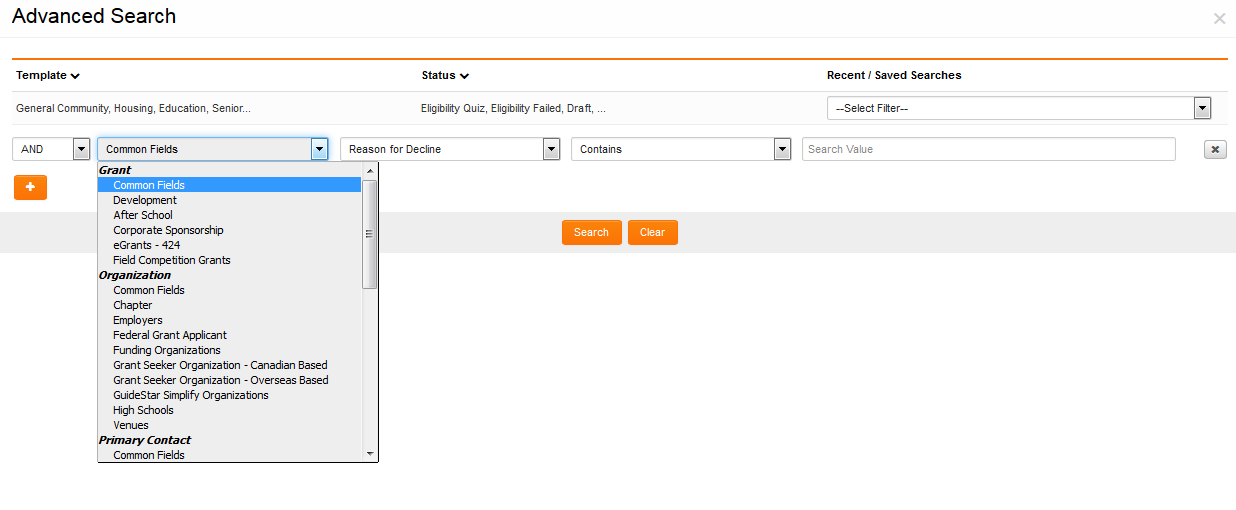
Illustrated is the Field Type dropdown option in the Advanced Search with some associated objects displayed (above).
Dynamic List View Filtering
The ability to filter searches based on UTA role. The following search options exist in UTA searches:
- My Level 1 - Owner
- My Level 1 - Person
- My Level 1 - Assigned in Role
- My Level 1 - Assigned in Companies
- My Level 1 - Assigned in Companies with Role
- Contacts Assigned in Role
- Companies Assigned in Role
- My Level 2 / Level 3 - Owner
- My Level 2 / Level 3 - Assigned in Role
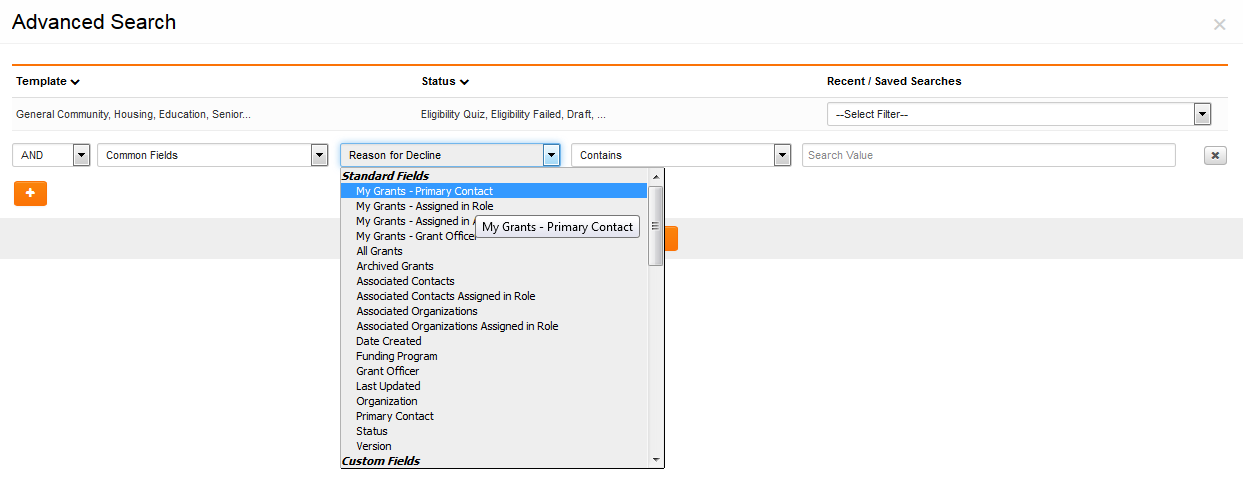
Illustrated is the field dropdown option in the Advanced Search with the new Level 1 filters included (above).
Multiple search criteria
Advanced Search enables quick and easy input of multiple search criteria including AND, OR and NOT operators.
Multiple criteria can be specified for searches, by clicking on the Add Criteria button at the bottom of the Advanced Search section. If searching for internal contacts in a list that includes:
- Adam Smith
- Bob Smith
- Cathy Jones, and
- David Williams
...the below set of search criteria will return a list of Adam Smith and Cathy Jones, but not Bob Smith.
Once selected, a set of criteria can be saved in the system as a filter, that can be re-applied later using the "Saved Filter" drop-down.
Note that, when searching for contacts and accounts, a checklist of roles and categories, respectively, will be displayed to further narrow down your search. When using Advanced Search on objects of Level 1, 2 or 3 within the Universal Tracking Application, Templates, Types and Statuses can be selected in the checklists.
Also, when searching against a Level 2 entity users will have the ability to search for the Level 2's based on Level 1 fields. In the screenshot below the options under the Grants heading relate to the Level 1 fields, whether those fields are common to all Level 2 types or are specific to a Level 2 Type.
Searching Dates
When using the Advanced Search to search a date field (both Standard or Custom fields) then the user is presented with a different series of search options to match against:
- On - returns records that have a date value in the selected field that matches exactly the date entered in the Search Term field.
- On or Before - returns records that have a date value in the selected field that either exactly matches or falls before the date entered in the Search Term field.
- On or After - returns records that have a date value in the selected field that either exactly matches or falls after the date entered in the Search Term field.
- Is empty - returns records that have no value in the selected field.
- Last Year - returns records that have a date value in the selected field of the previous year from the current year.
- This Year - returns records that have a date value in the selected field of the current year.
Saved Searches
Your last five searches will automatically be saved under the "Last Searches" heading, when you open the dropdown under the "Apply Filter" setting: